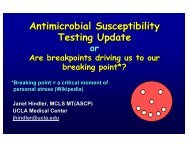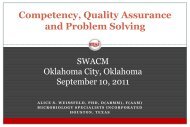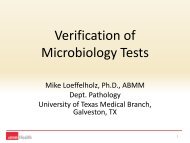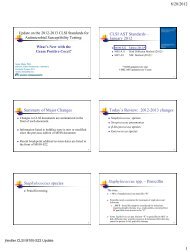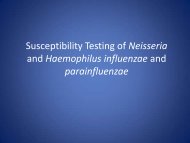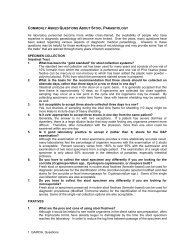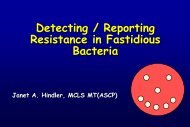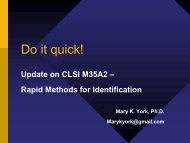Competency Assessment: More Important than Ever by ... - SWACM
Competency Assessment: More Important than Ever by ... - SWACM
Competency Assessment: More Important than Ever by ... - SWACM
Create successful ePaper yourself
Turn your PDF publications into a flip-book with our unique Google optimized e-Paper software.
<strong>Competency</strong> <strong>Assessment</strong>:<strong>More</strong> <strong>Important</strong> <strong>than</strong> <strong>Ever</strong>PRESENTED BY:ALICE S. WEISSFELD, PHD, D(ABMM), F(AAM)MICROBIOLOGY SPECIALISTS INCORPORATEDHOUSTON, TEXASSEPTEMBER 5, 2009
<strong>Competency</strong> <strong>Assessment</strong>:<strong>More</strong> <strong>Important</strong> <strong>than</strong> <strong>Ever</strong>OBJECTIVES•To learn how to use competency assessment as aimprovement toolperformance•To learn how to assess knowledge and skills•To understand how to use competency assessment as aopportunitytraining
Beginnings 1966: 60 Minutes Exposé on “Sink Testing” : Leads to calls forreform 1967 : Clinical Laboratory Improvement Act (CLIA '67) Applied only to laboratories engaged in Interstate Commerce (approx 12,000 or 7%) Required: Strict adherence to quality control standards (QC) Proficiency Testing (PT) Strict adherence to Standard Operating Procedures (SOPs) Personnel standards
Beginnings HCFA : Health Care Finance Administration, (eventually the name was changed tothe Center for Medicare and Medicaid Services(CMS) Agency of the Dept. of Health and Human Services (DHHS) , given regulatoryoversight to :Act as an enforcement arm for CLIA ’67Oversee Medicare and Medicaid Program 1987 Wall Street Journal : Exposé on “Pap Mills”, led to: 1988 Clinical Laboratory Improvement Amendments(CLIA ‘88)
Components of CLIA '88Extended oversight to any facility performing clinical laboratory testing(approximately 170,000 labs), including physician office labs (POLs)The level of regulation was determined <strong>by</strong> the complexity of testsperformedMandated employee training and ongoing assessment of competency toensure testing qualityOutlined components of the Laboratory <strong>Competency</strong> <strong>Assessment</strong>Program Direct observation of routine patient test performance Monitoring the recording and reporting of test results Review of test worksheets, and quality control (QC) records, PT results, andpreventive maintenance (PM) records
Components of CLIA '88 Direct observation of performance of instrument maintenance and functionsheets <strong>Assessment</strong> of performance through testing previously analyzed specimens,internal blind testing samples or external PT samples <strong>Assessment</strong> of problem-solving skills
CAP Q Probes ProgramQ Probes Results from 552 Institutions• Institutions with a written competency plan 89.2%• Institutions following their written plan in the lab 90.3%• Institutions reviewing employee competency at least annually 98.0% Through direct observation 87.5% Through review of test or QC results 77.4% Through review of instrument PM 60.0% Through written testing (poorest indicator) 52.2%Additional Survey Information: 6.4% failed to comply with their own lab’s plan 8.6% of employees failed their competency assessment but were allowed to continuetheir usual work
Standards for <strong>Competency</strong> Testing•CAP GUIDELINES•THE JOINT COMMISSION STANDARDS•MICROBIOLOGY CERTIFICATION REQUIREMENTS CLIA '88
CAP Guidelines Addressing <strong>Competency</strong> Testing CAP # GEN. 54750Question: For laboratories subject to U.S. federal regulations, do alltesting personnel meet CLIA ‘88 requirements?Answer: There must be evidence in personnel records that all testingpersonnel have been evaluated against CLIA ‘88 requirements , andthat all individuals qualify.
CAP Guidelines Addressing <strong>Competency</strong> Testing CAP # GEN. 55200 Question: Are there annual reviews of the performance of existingemployees and an initial review of new employees within the first 6months? Answer: The laboratory must conduct an annual performancereview of all employees. New employees must be reviewed within 6months of employment and annually thereafter.
CAP Guidelines Addressing <strong>Competency</strong> Testing CAP # GEN. 55500 Question: Has the competency of each person to perform his/herassigned duties been assessed? Answer: The manual that describes training activities andevaluation must be specific for each job description. The trainingand assessment program must be documented and specific for eachjob description. Activities requiring judgment or interpretive skillsmust be included. The records must make it possible for theinspector to be able to determine which skills were assessed andhow those skills were measured.
CAP Guidelines Addressing <strong>Competency</strong> Testing CAP # GEN. 55000 (cont’d)Some elements of competency assessment include but are not limitedto:Direct observation of routine patient test performance, including patientpreparation.If applicable, specimen handling, processing and testing Monitoring the recording and reporting of test results;Review of intermediate test results or worksheets, QC records, proficiency testingresults and preventive maintenance recordsDirect observation of performance of instrument maintenance and function checks<strong>Assessment</strong> of test performance through testing previously analyzed specimens,internal blind testing samples, or external proficiency testing samples; andEvaluation of problem-solving skills
CAP Guidelines Addressing <strong>Competency</strong> Testing CAP # GEN. 57000 Question: If an employee fails to demonstrate satisfactoryperformance on the competency assessment, does the laboratory have aplan of corrective action to retrain and reassess the employeescompetency? Answer: The laboratory should have a documented corrective-actionplan to retrain and reassess employee competency when problems areidentified with employee performance. If, after reeducation andtraining, the employee is unable to satisfactorily pass the assessment,then further action should be taken, which, may include closesupervisory review of work, reassignment of duties or other actionsdeemed appropriate <strong>by</strong> the Laboratory Director.
CAP Guidelines Addressing <strong>Competency</strong> Testing CAP # GEN. 58500 Question: Is there documentation of retraining and reassessmentfor employees who initially fail to demonstrate satisfactoryperformance on competency assessment? Answer: Documentation of retraining and reassessment ofemployees who initially fail competency assessment should beavailable.
The Joint Commission Standards Regarding<strong>Competency</strong> Testing HR 2.10 Standard: Orientation provides initial job training and information Explanation: As appropriate, each staff member, student, andvolunteer is oriented and then assessed to the following: The organization assesses and documents each person’s ability to carry out assignedresponsibilities safely, competently, and in a timely manner on completion of orientation The organization documents that each person has completed orientation and has beenevaluated for competency in performing required laboratory tasks as well as otherparameters defined in his or her job description Documentation of orientation participation includes written approval <strong>by</strong> the laboratorydirector or appropriate supervisor noting that the individual is capable of performinglaboratory duties and confirmation <strong>by</strong> the employee that he or she feels qualified afterorientation to perform the tasks required
The Joint Commission Standards Regarding<strong>Competency</strong> Testing HR. 2.30 Standard: Ongoing education, including in-services, training andother activities, maintains and improves competence. Explanation: The following occurs for staff, students and volunteerswho work in the same capacity as staff providing care, treatment,and services: Training occurs when job responsibilities or duties change Participation in ongoing in-services, training, or other activities occurs to increase staff,student, or volunteer knowledge of work-related issues Ongoing in-services and other education and training are appropriate to the needs of thepopulations served and comply with law and regulation
The Joint Commission Standards Regarding<strong>Competency</strong> TestingHR. 2.30 (cont’d) Ongoing in-services, training, or other activities emphasize specific job-related aspects ofsafety and infection prevention and control Ongoing in-services, training or other education incorporate methods of team training,when appropriate Ongoing in-services, training or other education reinforce the need and ways to reportunanticipated adverse events On-going in-services or other education is offered in response to learning needs identifiedthrough performance improvement findings and other data analysis (that is, data fromstaff surveys, performance evaluations, or other needs assessments) On-going education is documented At a minimum, for supervisory staff, attendance at outside workshops, institutes, andlocal, regional or national society meetings occurs as feasible
The Joint Commission Standards Regarding<strong>Competency</strong> Testing HR.3.10 Standard: Competence to perform job responsibilities is assessed,demonstrated, and maintained Explanation: <strong>Competency</strong> assessment is systematic and allows for ameasurable assessment of the person’s ability to perform requiredactivities. Information used as part of competency assessment mayinclude data from performance evaluations, performanceimprovement and aggregate data on competency, as well as theassessment of learning needs. This standard encompasses thefollowing:
The Joint Commission Standards Regarding<strong>Competency</strong> Testing HR.3.10 (cont’d) The laboratory director or appropriate laboratory supervisor regularly assesses the continuedcompetency of staff on all laboratory work shifts through performance evaluations Staff members are evaluated for competency in performing required laboratory tasks asapplicable, as well as for all other parameters defined in their job descriptions Supervisory staff are evaluated for performance of their job responsibilities, as defined in theirjob descriptions A job description and a completed competency assessment, an evaluation, or an appraisal toolare on file for each contracted or employed individual Each staff member’s performance is evaluated and documented after orientation and annuallythereafter An individual qualified to provide technical judgments about performance evaluates technicalstaff The procedures to assess and document annually the competency of technical staff include butare not limited to the following:
The Joint Commission Standards Regarding<strong>Competency</strong> TestingHR.3.10 (cont’d)Routine patient test performance, including patient preparation, if applicable, and specimencollection, handling, processing, and testingThe recording and reporting of test resultsQC, proficiency testing, and preventive maintenance performanceInstrument function checks and calibration performanceTest performance assessment as defined <strong>by</strong> laboratory policy (e.g., testing previously analyzedspecimens, internal blind testing samples, and external proficiency or testing samples)<strong>Assessment</strong> of problem-solving skills as appropriate to the job If a test method or instrumentation changes or the individual’s duties change, his or herperformance is reevaluated to include skills in the areas of change Each laboratory employee performing such tests participates in the program Acceptable performance criteria are established Performance levels are documented When indicated, remedial action is taken and documented
The Joint Commission Standards Regarding<strong>Competency</strong> Testing LD.2.90• Standard: The laboratory director is responsible for determining thequalifications and competency of laboratory staff• Explanation: The director determines the procedures and tests that staffmembers are qualified and authorized to perform and is responsible fordetermining the competence and qualifications of laboratory staff. Thedirector ensures that the level of supervision provided and the level oftesting complexity is commensurate with the education, training , andexperience of staff. The director must also require that staffdemonstrate the ability to perform all duties before actually testingpatient specimens and that all staff maintain competencies to performrequired tasks.
Summary of <strong>Competency</strong> <strong>Assessment</strong>Items That Must be Included in a <strong>Competency</strong> <strong>Assessment</strong>ProgramDirect observation of routine patient test performance• Description: This is the actual observation of work as it is being performed <strong>by</strong>the laboratory staff. Not limited to test performance but include all processesin which the employee is involved, including specimen collection, preparation,as well as the actual testing of the specimens.• Examples: Used for areas involving a higher degree of decision making orhaving a significant impact on patient care (e.g., new positive blood cultures,positive cerebrospinal fluid specimens, susceptibility testing, accurateinterpretation of test reactions, following appropriate work instructions)
Summary of <strong>Competency</strong> <strong>Assessment</strong>Items That Must be Included in a <strong>Competency</strong> <strong>Assessment</strong>ProgramMonitoring the recording and reporting of test results• Description: Review of patient results for the proper and correct recordingand reporting• Examples: This can be accomplished <strong>by</strong> the documentation of observation ofan employee writing or entering patient test results on report forms or intothe computer or <strong>by</strong> review of worksheets with report forms or computerentries.
Summary of <strong>Competency</strong> <strong>Assessment</strong>Items That Must be Included in a <strong>Competency</strong> <strong>Assessment</strong>ProgramReview of test results, QC records, proficiency testing results, andpreventive maintenance records• Description: One must review patient results.• Examples: This can be accomplished <strong>by</strong> review of worksheets or computerentries for accurate recording of patient results, review of QC worksheets orprintouts for acceptable results (within QC parameters) and for review ofpreventive maintenance records for the appropriate and timely checks anddocumentation.
Summary of <strong>Competency</strong> <strong>Assessment</strong>Items That Must be Included in a <strong>Competency</strong> <strong>Assessment</strong>ProgramDirect observation of performance of instrument maintenanceand function checks• Description: Direct observation must be used when employees areperforming maintenance procedures and check of instruments.• Examples: One must directly observe an employee when performingmaintenance procedures and function checks on instruments in thelaboratory, such as the automated identification/susceptibility testinginstrument, molecular diagnostic instrumentation, and blood cultureinstrumentation.
Summary of <strong>Competency</strong> <strong>Assessment</strong>Items That Must be Included in a <strong>Competency</strong> <strong>Assessment</strong>Program<strong>Assessment</strong> of test performance through testing previouslyanalyzed specimens, internal blind testing samples, or externalproficiency testing samples• Description: One must assess employee competence <strong>by</strong> giving them unknownsamples to evaluate as they would evaluate patient samples in the laboratory.• Examples: This can be accomplished <strong>by</strong> split-sample analysis, previouslyanalyzed specimens, blind internal proficiency testing, or externalproficiency testing such as CAP surveys, etc.
Summary of <strong>Competency</strong> <strong>Assessment</strong>Items That Must be Included in a <strong>Competency</strong> <strong>Assessment</strong>Program<strong>Assessment</strong> of problem-solving skills• Description: One must assess the ability of employees to solveproblems that arise during their culture analysis.• Examples: This can be accomplished <strong>by</strong> (i) asking the employees towrite up a situation where they had to solve a problem that related toan investigation they performed or (ii) giving a fictitious (or real)example of a problem encountered in the laboratory and asking theemployee how he or she would handle the situation.
Microbiology Certification Requirements: CLIA '88Test Complexity Level Personnel Minimum QualificationsModerate Director Physician (MD,DO,DDS,DPM)or PhD in science; must have 1year of supervisory experience ifnot a board-certified pathologistor doctoral scientistorTechnical Consultant(responsible for technicaloversight if a nurse ornon-medical technologistis the laboratory director)Baccalaureate degree in scienceplus 2 years of laboratorytraining and experience and 2years of supervisory experience.Baccalaureate degree in scienceplus 2 years of experience
Microbiology Certification Requirements: CLIA '88Test Complexity Level Personnel Minimum QualificationsModerate (continued)Clinical consultant (liaisonbetween laboratory andclinicians)Testing PersonnelPhysician (MD, DO, DDS,DPM) or board certifieddoctoral scientistHigh school diploma plusdocumentation of on-the-jobtraining.High Director Physician (MD, DO, DDS,DPM) or board certifieddoctoral scientistTechnical supervisorBaccalaureate degree inscience plus 4 years oflaboratory experience in highcomplexity testing.
Microbiology Certification Requirements: CLIA '88Test Complexity Level Personnel Minimum QualificationsHigh (continued) General supervisor Associate degree in medicallaboratory science plus 2years of laboratory experiencein high complexity testing.Clinical consultant (can bedirector)Physician (MD, DO, DDS,DPM) or board certifieddoctoral scientistTesting personnelAssociate degree in medicallaboratory technology orlaboratory science.
Training, Evaluation and<strong>Assessment</strong> Tools• MSI ADMINISTRATIVE PROCEDURE MANUAL CC070• CLIA '88 Personnel Evaluation Form• MSI Employee Training Record Form• MSI Training Standards: Technical Benches• MSI Training Standards: Processing• MSI LABORATORY EMPLOYEE COMPETENCY EVALUATION FORM• USE OF INTERNAL AUDIT TO ALSO ACCESS EMPLOYEE COMPETENCY
CLIA '88 Personnel Evaluation Formmicrobiology specialists inc.I have reviewed the training and experience of_______________________________and they meet the CLIA ‘88 requirements for employment as a_______________________________.____________________________Alice S. Weissfeld, Ph.D.Director______________Date
Why are Training and <strong>Competency</strong> so <strong>Important</strong>? Medical errors in which the laboratory is involvedhave been attributed to: Training not being provided Training being ineffective
Administrative Procedure CC070:On the Job TrainingON-THE-JOB-TRAINING05/08/96Approved <strong>by</strong>: ASW:PHV:ETEffective Date:Revision Date: 10/24/08Administrative: CC070I. PRINCIPLE:To assure that all technical staff are adequately trained, an on-the-job training program (OJT) hasbeen developed. This procedure outlines the steps involved.II. PROCEDURE:A.The Laboratory Director will assess all technical employees at the time of employment for their suitabilityto perform clinical testing. Individuals with appropriate education and professional certification will then gothrough Microbiology Specialists Inc. OJT.B.msi® OJT consists of mastery of multiple tasks as outlined in this SOP. The program begins with theaccessioning and set-up of specimens and the performance of direct exams. The entire process can take3-5 years.C.Day shift jobs are divided <strong>by</strong> benches. Each bench (Bacteriology, Virology, Mycobacteriology, Mycology,Parasitology, Molecular, and Special Studies) has a general list of tasks. Because of the extensive list ofprocedures, trainers and trainees are referred to procedure manuals for each bench.
MSI Administrative Procedure CC070:On the Job TrainingD. When both trainers and trainees feel that the trainees are ready to do a bench themselves, thetrainees will have their work reviewed closely <strong>by</strong> supervisory personnel, including reviewing cultureplates, slides, etc.E. When trainees have 2-3 months of experience on a bench, they are given a competency evaluation toassess their abilities. In all cases, all employees who have been at work for six months will have acompetency evaluation.F. Individuals with favorable competency ratings are checked off as having learned that bench on the“Employee Training <strong>Assessment</strong>” form.G. After training on a bench and after favorable competency has been assessed, the employee will signthe front of the appropriate procedure manual acknowledging their competency with that SOP.1. All subsequent additions and revisions to each SOP are reviewed and initialed <strong>by</strong> thelaboratory director, each technologist and all supervisors.H. Annual <strong>Assessment</strong> of Employee competency:1. After initial training and competency evaluation, technical employees will be evaluated yearlythereafter.2. <strong>Competency</strong> records are kept in the employee’s personnel file.3. Employees failing their annual competency evaluation will have documented re-training and retestingin areas found to be lacking.
MSI Employee Training RecordEmployee’s Name:_______________________________________PROCEDURE ANALYST TRAINER DIRECTORTechnical BenchesBacteriologyAnaerobesClinicalsAerobic IDsVirologyMycologyMycobacteriologyAFB 1AFB 2Parasitology
MSI Employee Training RecordPROCEDURE ANALYST TRAINER DIRECTORMolecularGen-Probe Pace 2Miscellaneous (AM)Quality ControlProcessingBacteriologyVirologyAFB/MycologyPaper/Set-Up___________________________________________Employee Signature___________________________________________Lab Director_____________________Date_____________________Date
MSI OJT Training Standards: Technical BenchesClinicals: BACTERIOLOGY- All clinical procedures are outlined in the Bacteriology Procedure Manual-Set-up / assess susceptibilities <strong>by</strong> following methodology:MICsKir<strong>by</strong>-Bauer susceptibilitiesε-test-Prepare and inoculate standard biochemicals and assess their reactionsAnaerobes:-All anaerobe procedures are outlined in the Anaerobic Procedure Manual-Set-up / assess susceptibilities <strong>by</strong> MIC methodology-Prepare and inoculate standard biochemicals and assess their reactions-Process and assess Gas Liquid Chromatography (GLC) patterns
MSI OJT Training Standards: Technical BenchesAerobic Identifications: BACTERIOLOGY (cont’d)-All aerobic identification procedures and corresponding identification charts areoutlined in the Aerobic Identification Manual-Prepare and inoculate standard biochemicals and assess their reactions-Set-up / assess susceptibilities <strong>by</strong> the following methodologies:MICsKir<strong>by</strong>-Bauerε-test-Use of selected charts containing biochemical reactions to identify human pathogenicorganismsThe following Procedure Manuals have been referenced above:Bacteriology Procedure ManualAnaerobe Procedure ManualAerobic Identification Procedure ManualBacti Test ProceduresSusceptibility Test ProceduresKing charts
MSI OJT Training Standards: Technical Benches VIROLOGYAll virology procedures are outlined in the Virology Procedure Manual.-Reading tissue culture cell tubes (dailies and weeklies)-Prepare, fix, stain and assess direct/indirect fluorescent antibody (DFA)/IFA stains forviral confirmation-Hemadsorption Test Procedure-Acid-Test Procedure-Reporting of test resultsThe following procedure manual has been referencedabove:Virology Procedure Manual
MSI OJT Training Standards: Technical Benches MYCOLOGYAll mycology procedures are outlined in the Mycology Procedure Manual.-Prepare / assess Calcaflour white (CFW) stains-Special stains:-API 20Cs-Kinyoun’s stain-Q-stain-Potassium hydroxide prep (KOH)-Lactophenol aniline prep-Biochemical identification tests for moulds and yeasts-Macroscopic and microscopic identification of mouldsThe following procedure manual has been referencedabove.Mycology Procedure Manual
MSI OJT Training Standards: Technical Benches MYCOBACTERIOLOGYAll mycobacteria procedures are outlined in the Mycobacteriology Procedure Manual.-Bactec procedure methods-Identification tests for mycobacteria-DNA probes for mycobacteria identification-Standard and special susceptibilities for mycobacteria-Auramine – rhodamine stain-Ziehl – Neelsen stainThe following procedure manual has been referencedabove:Mycobacteriology Procedure Manual
MSI OJT Training Standards: Technical Benches PARASITOLOGYAll parasitology procedures are outlined in the Parasitology Procedure Manual-Collection and use of preservative transports-Microscopic examination:-Formalin concentrate-Trichrome stain-Special stains:-Giardia/Cryptosporidium fluorescent stain-Microsporidia-Modified acid-fast-Detection of blood parasitesThe following procedure manual has been referencedabove.Parasitology Procedure Manual
MSI OJT Training Standards: Technical Benches MOLECULARNon-amplified tests:-Gen-Probe Pace 2The following procedure manuals have been referenced above:Molecular Procedure ManualIndividual Manufacturer’s Procedure and Equipment Manuals
MSI OJT Training Standards: Technical Benches MISCELLANEOUS STAINSDirect Microscopy-Viral DFA or IFA-Calcafluor white-Auramine – rhodamine-Ziehl-Neelsen-Gram stain-Kinyoun’s stain-Q stain-Legionella stainThe following procedure manuals have been referencedabove:Bacti Test Procedure ManualVirology Procedure ManualMycology Procedure ManualMycobacteriology Procedure Manual
uality Control Procedure ManualEquipment Quality Control Procedure ManualMSI OJT Training Standards: Technical Benches QUALITY CONTROL (QC)All QC procedures are outlined in the Quality Control Manual and in the Equipment Quality ControlManual-Performance of <strong>by</strong>-lot QC-Performance of daily periodic QC-Performance of weekly periodic QC-Performance of monthly periodic QC-Performance of equipment QCThe following procedure manuals have been referenced above:Quality Control Procedure ManualEquipment Quality Control Procedure Manual
MSI OJT Training Standards: Processing-Homogenization of tissue Bacteriology:-Use of appropriate media for culture (as outlined in laboratory Bacteriology Manual)-E.coli 0157-Salmonella / Shigella-Streptex Serotyping: Virology:-Preparation and inoculation of tissue culture cells-Preparation of direct exam slides-Preparation and inoculation of shell vials (Rapid culture technique)-Preparation of special PMK refeed medium
MSI OJT Training Standards: Processing-Bacti Notes:-Gram stains-Catalase-Oxidase-LAP-PYR-Susceptibilities (set up)-ε-test-Inoculation including:-Kir<strong>by</strong>-Bauer-Andrades sugars-OF sugars-TSI-LIA-Urea-MIO Miscellaneous:
MSI OJT Training Standards: Processing-Direct fluorescent microscopy:-Herpes simplex type 1 & 2-Varicella-zoster-Respiratory Syncytial Virus-Influenza A&B-Legionella-Non-amplified DNA probes:-Chlamydia-Neisseria gonorrhea (GC)-Chlamydia/GC Probe competition assay-India Ink exams (CSF /urine)-Clostridium difficile Cytotoxin Assay (set-up) Miscellaneous: (cont’d)
MSI OJT Training Standards: Processing-AFB-Preparation / Digestion-Preparation of direct exam slides-Inoculation of appropriate culture media AFB/Mycology:-Mycology-Preparation /Digestion-Homogenization/Mincing-Preparation of direct exam slides-Inoculation of appropriate culture media-Tease mounts/Scotch-tape preparations-API 20Cs (preparation/inoculation)
MSI OJT Training Standards: Processing-Paper / Set-Up-Accessioning of patient specimens-Labeling of patient specimens-Work card attachment-Tissue culture cell quality assessment-Set-up of appropriate tissue culture cell lines on viral cultures-Mail-Epidemiology reports-Distribution of computer reports-Check calendarThe following procedure manuals have been referenced above:Bacteriology Procedure ManualVirology Procedure ManualMycobacteriology Procedure ManualMycology Procedure ManualParasitology Procedure ManualPaper work Procedure ManualAdministrative Procedure ManualBacti Test Procedure Manual
MSI Laboratory Employee <strong>Competency</strong> Evaluation FormEmployee’s Name:Date of Evaluation:Evaluator’s Name:Bench:Numerical Parameters1=16 errors or more for each task2= 9-15 errors or more for each task3= 8 errors or less for each task4= 5 errors or less for each task5= 2 errors or less for each taskAppearanceNeatnessLegibilityWorkcards 1 2 3 4 5 1 2 3 4 5
MSI Laboratory Employee <strong>Competency</strong> Evaluation FormSample Set-Up and TransportWere samples transported at correct temperature?Were samples preserved correctly for transport?Were sample requests date stamped?Did sample label match Requisition Form?Were samples logged correctly?Were shared, priority or special instructions noted on sample requisition?Were safety precautions for the transport and ‘check-in” of samples utilized?Were all tests set-up as ordered?Were samples inoculated onto appropriate media?Were inoculated samples incubated appropriately?Were left over samples saved appropriately?1 2 3 4 5 N/A1 2 3 4 5 N/A1 2 3 4 5 N/A1 2 3 4 5 N/A1 2 3 4 5 N/A1 2 3 4 5 N/A1 2 3 4 5 N/A1 2 3 4 5 N/A1 2 3 4 5 N/A1 2 3 4 5 N/A1 2 3 4 5 N/A
MSI Laboratory Employee <strong>Competency</strong> Evaluation FormSpecimen Work-UpWere work cards easy to read?Were the correct biochemicals, slides, or subcultures set up?Did decision making processes yield proper results and follow protocols?Was each day’s work dated and initialed?Were all biochemicals, slides, or subculture results recorded?Were biochemicals inoculated properly?Was all work completed in a timely manner?Were specimen stains read correctly?Were specimens overworked?Were safe work practices observed?Were priority requests done in a timely manner?1 2 3 4 5 N/A1 2 3 4 5 N/A1 2 3 4 5 N/A1 2 3 4 5 N/A1 2 3 4 5 N/A1 2 3 4 5 N/A1 2 3 4 5 N/A1 2 3 4 5 N/A1 2 3 4 5 N/A1 2 3 4 5 N/A1 2 3 4 5 N/A
MSI Laboratory Employee <strong>Competency</strong> Evaluation FormQuality ControlWere check plates done when appropriate? 1 2 3 4 5N/AWere necessary controls performed? 1 2 3 4 5N/AWere periodic QC controls performed? 1 2 3 4 5ReportingN/AWas confidentiality maintained?1 2 3 4 5 N/AWere verbal reports given and documented?1 2 3 4 5 N/AWere final reports correct?1 2 3 4 5 N/AWere reports given in a timely manner?1 2 3 4 5 N/AWere all reports logged out?1 2 3 4 5 N/AWas supervisory review appropriate?1 2 3 4 5 N/A
MSI Laboratory Employee <strong>Competency</strong> Evaluation FormConclusionOverall performance of employee at this bench (average of tasks evaluated) 1 2 3 4 5Is retraining necessary? Yes NoNote: Overall satisfactory performance does not mean retraining is not necessary. Each task is evaluatedindividually for retraining purposes. Retraining is required on each task that has a score of less <strong>than</strong> 3.Additional comments:
MSI Laboratory Employee <strong>Competency</strong> Evaluation FormAcknowledgementEmployee SignatureDateEvaluator’s SignatureDateFollow-UpEmployee SignatureDateEvaluator’s SignatureDate
Remedial Actions for Failure Discuss SOP with employee and determine root cause of problem.• Have employee produce a flow chart to help them properly perform SOP Have employee observe another trained and competent employee Have employee practice the failed procedure with known specimens. Have employee retest the same clinical specimens under directobservation If, after reeducation and training, the employee is unable tosatisfactorily pass the assessment, then further action should betaken, which, may include supervisory review of all work,reassignment of duties or other actions deemed appropriate <strong>by</strong> theLaboratory Director
Using an Internal Audit to Also Assess Employee Competence• Title: Urine Cultures, Pre-analytical, Analytical, and Post-analytical Review• Purpose:To assess whether contaminated urine samples were being submitted <strong>by</strong> clientsTo review whether technologists were adhering to specimen work-up and reportingguidelines for urine cultures• Design: Evaluated all urine culture submitted between January-March 1993• Data: 233 specimens were submitted for urine culture:• 23.6% were positive for significant organisms• 45.5% were sterile• 34.3% contained ore or more organisms of contaminating flora
Analysis of Urine Samples SubmittedCLIENTTOTALNO. OFSPECIMENSSTERILECULTURESPOSITIVECULTURESWITH NOCONTAMINTINGFLORAPOSITIVECULTURESWITHCONTAMINTINGFLORAPRESENT%POSI-TIVECULTURESWITH ASINGLECONTAMIN-ANTCULTURESWITHMIXEDCONTAMIN-ANTSPERCENT OFCULTURESSHOWINGCONTAMIN-ATION1 123 60 27 6 26.8 18 12 29.32 54 9 13 4 31.5 15 12 57.43 1 0 1 0 0 0 0 04 25 19 3 0 13 1 2 125 24 15 0 0 0 6 3 37.56 1 0 0 0 0 0 1 1007 3 3 0 0 0 0 0 08 1 0 1 0 0 0 0 09 1 0 0 0 0 1 0 100TOTAL 233 106 45 10 - 41 29 -
Using an Internal Audit to Also Assess Employee Competence PRE-ANALYTICAL REASONS FOR CONTAMINATION Specimen collection <strong>by</strong> Clients• There were too many contaminated urine specimens submitted for work up. Client#1 submitted 29.3% contaminated specimens, Client #4 had 12%, and Client #5 had37.5% contaminated specimens.• The requisition forms were not filled out with adequate information in the clinicalsyndrome category. <strong>More</strong> patient information (i.e., symptoms) would be useful indeciding if low colony counts are significant.
Using an Internal Audit to Also Assess Employee Competence ANALYTICAL Technologist Errors• Twelve cultures should have been held an additional 24 hrs. due to the presenceof 4+ enteric gram-negative rods, gram-positive cocci in clusters or yeast seenon direct exam. None of these organisms were noted on the culture after 24hours of incubation. Therefore, the direct exam did not agree with the cultureresults that were reported.• Four cultures were reported out as contaminated with 2-3 different organisms.Each isolate was >10 2 organisms/ml with none being predominant. Entericgram-negative rods or S. saprophyticus should have been pursued if thepatient was symptomatic. The client should have been called to ascertain thisinformation.
Using an Internal Audit to Also Assess Employee Competence• Technologist Errors (cont’d)• In three instances, a report of a single isolate of
Using an Internal Audit to AlsoAssess Employee Competence POST-ANALYTICAL Supervisory Review Errors• None of the errors listed above were caught <strong>by</strong> review of the reportbefore it went out.
Using an Internal Audit to Also Assess Employee Competence Clerical Errors• One report was filed without organism identification• One report had a susceptibility performed and reported, but the final report didnot note “Susceptibility attached”
Using an Internal Audit to Assess Employee Competence Conclusions/Recommendations• The urine culture procedure should be revised to include more preciseinstructions for specimen work-up. Included will be a category for cultures thatshould be incubated an additional 24 hours and which cultures should becalled to the client to determine if the specimen was from a symptomaticpatient.• Clients submitting more <strong>than</strong> 10% contaminated urine specimens will be senta letter re-emphasizing the correct technique for collecting a urine specimen.Ask that more patient information (especially if the patient has symptoms of aUTI) be filled out on the test requisition. Give a brief description of “AcuteUrethral Syndrome” and let the clients know that the lab will be calling aboutcultures that fit the criteria of AUS (i.e. the presence of low numbers of entericgram-negative rods or possible S. saprophyticus) unless adequate patientinformation is given on the test requisition.
Using an Internal Audit to Assess Employee Competence Conclusions/Recommendations• <strong>More</strong> information needs to be included on the direct exam workcard.Include descriptions of gram positive rods– are they chaining or beaded?Are they attached to epithelial cells? Are gram-positive cocci chaining or inclusters. The Fifth edition of the Manual of Clinical Microbiology reportsthat C. pseudodiphtheriticum, Group JK and Group D-2 can cause UTI.Group E has been implicated in cases of pyelonephritis and “C. genitalium”may cause urethritis. Be aware that all gram positive rods in urine are notLactobacillus or G. vaginalis.• All technologists and supervisors should review the revised urine cultureprocedure and read the attached information on “Acute urethral Syndrome”.
References McCarter, Y.S. and A Robinson. 1997. <strong>Competency</strong> assessment in clinical microbiology.Clin.Micro.Newsl. 19: 97-101. Sharp, S.E. 2001. Initial training verification and competency assessment in the clinical microbiologylaboratory. Clin.Micro.Newsl. 23: 79-91. Elder, B.L. and S.E. Sharp. 2003. Cumitech 39: competency assessment in the clinical microbiologylaboratory. Coordinating ed., S.E. Sharp. ASM< Press, Washington, DC. Sharp, S.E. 2004. <strong>Competency</strong> assessment in the clinical microbiology laboratory.Clin.Microbiol.Rev. 17: 681-694. NCCLS. 2004. Training and competence assessment; Approved guideline-Second edition. GP21-A2.Wayne, PA.



